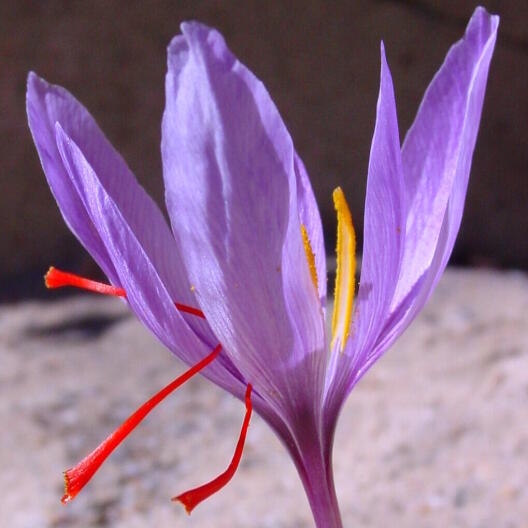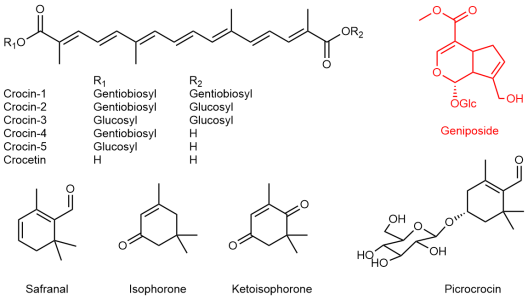Saffon-based food supplements

The spice saffron is obtained from the dried stigmas of Crocus sativus L. (Iridaceae) (Fig. 1).
Phytochemically, saffron is characterised by the presence of (coloured) crocines, (bitter-tasting) picrocrocin and various volatile aromatic substances (e.g. safranal, isophorone and ketoisophorone, Fig. 2). Very high quality saffron samples can contain up to 30 % crocin, 15 % picrocrocin and more than 0.5 % of the volatile fraction.
Due to an antidepressant effect shown in various independent studies, saffron has also come into medical focus. Today, it is suspected that crocetin, i.e. the aglycone of crocine, is formed intestinally and is responsible for the neuroprotective effects. Saffron has not yet been reviewed by the Committee for Herbal Medicinal Products (HMPC) of the European Medicines Agency (EMA). As far as we know, there are currently no marketing authorisations for saffron preparations in Germany either, but saffron-based food supplements (NEM) can be found on the market.

Since saffron is a very expensive spice and is known to be frequently adulterated, nine saffron-based food supplements were to be analytically examined in the present study in order to gain an insight into the current quality situation. The products investigated are offered in capsule form and contain saffron extract according to the declaration given.
Instrument parameters, analysis conditions and example chromatograms
The investigated food supplements can be divided into three categories according to the dosage level: A1 - A3 (15 mg), B1 - B5 (30 mg) and C1 (28 mg). With the exception of A3 and B5, all other products contain other "botanicals" as ingredients besides saffron, e.g. rhodiola extract in A1 and B1, rice extract in A2 and C1 and lavender extract in B3. Among others, the following quality parameters were investigated:
1. Authenticity (HPLC-UV fingerprint, if necessary HPLC/MS and microscopy).
2. Quantification (HPLC/UV): Crocin-1, Crocin-2, Picrocrocin and Safranal.
The overall conclusion is positive.
With only one exception (B5), all the tested food supplements contain the typical saffron ingredients. The determined contents of crocin and picrocrocin can also be assessed as typical for saffron. Only the contents of safranal (representing the volatiles) are very low throughout. Here, however, it can be assumed that it has depleted due to processing or storage.
Microscopic examination: The tissue fragments and pollen grains typical for saffron are found in all samples examined (except in B5).
In the case of product B5 (HerbalPlant Red Gold Safran-Extrakt, Lot. 21AQ183B, MHD 01.06.2024), further conspicuous features were found: high crocin-1 but low crocin-2 content, absence of picrocrocin and safranal. Using high-resolution MS, there was an indication of the possible presence of the iridoid glucoside geniposide (cf. Fig. 2), which is described in the literature as an ingredient of the fruits of Gardenia jasminoides J.ELLIS. Gardenia fruits are frequently mentioned in the literature in connection with saffron, as they also contain crocin and are not easy to detect in saffron samples by simple UV quality tests. Thus, it can be assumed that B5 does not contain saffron (absence of the typical C10 terpenes, atypical crocin pattern, presence of geniposide, which is not a component of saffron). In this case, it could be a counterfeit product. According to the manufacturer's notification (10.5.2022), the product has since been withdrawn from the market.
Detailed results have been published in a scientific journal: DOI 10.1055/a-1716-9696


